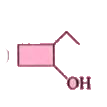which one of the following is (A−B)∪(B−A)?
(A∪B)∪(A−B)
(A∪B)∪(A∩B)
(A∪B)−(A∩B)
(A−B)∩(A−B)
The correct Answer is:C
To solve the problem of finding which one of the following is equal to (A−B)∪(B−A), we can follow these steps:
Step 1: Understand the Sets
- Set A: Represents one group of elements.
- Set B: Represents another group of elements.
- A−B: This represents the elements that are in set A but not in set B.
- B−A: This represents the elements that are in set B but not in set A.
Step 2: Write the Expression
The expression we need to evaluate is:
(A−B)∪(B−A)
This means we are looking for the union of the elements that are only in A and the elements that are only in B.
Step 3: Visualize with a Venn Diagram
To better understand this expression, we can use a Venn diagram:
- Draw two overlapping circles, one for set A and one for set B.
- Shade the part of circle A that does not overlap with circle B (this is A−B).
- Shade the part of circle B that does not overlap with circle A (this is B−A).
- The total shaded area represents (A−B)∪(B−A).
Step 4: Identify What is Left Out
The parts that are not shaded in the Venn diagram are the elements that are in both A and B (the intersection A∩B). Therefore, the union of A−B and B−A excludes the intersection.
Step 5: Express in Terms of Union and Intersection
From the Venn diagram, we can conclude that:
(A−B)∪(B−A)=(A∪B)−(A∩B)
This means that the union of the two sets minus their intersection gives us the desired result.
Step 6: Conclusion
Thus, the expression (A−B)∪(B−A) can be rewritten as:
A∪B−A∩B
Now, we can check the options provided in the question to find the equivalent expression.
- Set A: Represents one group of elements.
- Set B: Represents another group of elements.
- A−B: This represents the elements that are in set A but not in set B.
- B−A: This represents the elements that are in set B but not in set A.
The expression we need to evaluate is:
(A−B)∪(B−A)
This means we are looking for the union of the elements that are only in A and the elements that are only in B.
To better understand this expression, we can use a Venn diagram:
- Draw two overlapping circles, one for set A and one for set B.
- Shade the part of circle A that does not overlap with circle B (this is A−B).
- Shade the part of circle B that does not overlap with circle A (this is B−A).
- The total shaded area represents (A−B)∪(B−A).
The parts that are not shaded in the Venn diagram are the elements that are in both A and B (the intersection A∩B). Therefore, the union of A−B and B−A excludes the intersection.
From the Venn diagram, we can conclude that:
(A−B)∪(B−A)=(A∪B)−(A∩B)
This means that the union of the two sets minus their intersection gives us the desired result.
Thus, the expression (A−B)∪(B−A) can be rewritten as:
A∪B−A∩B
Now, we can check the options provided in the question to find the equivalent expression.
Topper's Solved these Questions
- SETSBOOK - OBJECTIVE RD SHARMA ENGLISHCHAPTER - SETSEXERCISE - Exercise
45 Videos
- SETSBOOK - OBJECTIVE RD SHARMA ENGLISHCHAPTER - SETSEXERCISE - Chapter Test
30 Videos
- SETSBOOK - OBJECTIVE RD SHARMA ENGLISHCHAPTER - SETSEXERCISE - Chapter Test
30 Videos
- SEQUENCES AND SERIESBOOK - OBJECTIVE RD SHARMA ENGLISHCHAPTER - SEQUENCES AND SERIESEXERCISE - Chapter Test
59 Videos
- STRAIGHT LINESBOOK - OBJECTIVE RD SHARMA ENGLISHCHAPTER - STRAIGHT LINESEXERCISE - Chapter Test
34 Videos
Similar Questions
Knowledge Check
If the point (a,b) is in Quadrant II and |a|−|b|>0, then which one of the following is true?
Aa>0Bb>0Ca>bDa+b<0If P(A∩B)=13,P(A∪B)=56andP(A)=12, then which one of the following is correct ?
AA and B are independent eventsBA and B are mutually exclusiveCmutually exclusiveDnone of these
Which one of the following is correct structure of 'B'?A B
B C
C D
D
If A={1,2,3,4},B={3,4,5},C={1,5,6}, then findof the following :
(i) A∪B
(ii) A∪(B∩C)
(ii) A−B
(iv) A−(B∪C).
View SolutionConsider the following sets:
A= set ofnaturai numbers which are multiples of 2
B= set ofnaturai numbers which are multiples of 3
C= set ofnaturai numbers which are multiples of 5
Then find the following set
(i)A∪B(ii)B∪C(iii)A−B(iv)B−C(v)A∩C<br>(vi)A∩B∩C(vii)(A∪B)−C
View SolutionIf A and B are two sets such that n(A)=15,n(A∪B)=40andn(A∩B)=5, then find each of the following :
(i) n(B)
(ii) n(A−B)
(iii) n(B−A)
View SolutionIf sets A=[−4,1]andB=[0,3), then find the following sets:
(a) A∩B (b) A∪B (c ) A−B
(d) B−A (e ) (A∪B)' (f) (A∩B)'
View SolutionIn which of the following , plasticity can be seen due to the changing environment ?
(a) Cotton
(b) Coriander
(c) Butter Cup
(d) Larkspur
View Solution
